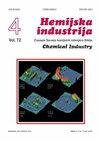Comparative analysis of functionality of spray dried whey protein hydrolysates obtained by enzymatic and microbial hydrolysis
IF 0.8
4区 工程技术
Q4 ENGINEERING, CHEMICAL
引用次数: 1
Abstract
The aim of this study was to examine the bioactive potential of hydrolysate powders produced by enzymatic and microbial hydrolysis of whey proteins followed by spray drying, in order to reveal which one of these processes result in a product with significantly improved functional properties. Hydrolysate powders produced by the two different biotechnological processes were compared based on their antioxidant (DPPH and FTC), antibacterial as well as erythrocyte membrane stabilizing activities. The performed tests revealed that the concentration of at least 178.4 mg mL -1 of the whey protein hydrolysate powder, produced by tryptic digestion, could inhibit the process of lipid peroxidation by 50 %, suppress the microbial contamination caused by S. aureus ATCC25923, B. cereus ATCC 11778 and L. monocytogenes , and provide the antioxidant and membrane stabilizing activities greater than 50 %. On the other hand, the hydrolysate powder obtained by whey fermentation at the concentration of at least 811.5 mg mL -1 achieved 50 % of all tested bioactivities, with the emphasis on the significantly more pronounced antibacterial activity against all tested strains. In that sense, tryptic hydrolysis could be highlighted as an optimal process that provides production of the whey hydrolysate with pronounced bioactive properties that could be considered as a very promising natural food supplement.酶解与微生物水解喷雾干燥乳清蛋白水解产物功能的比较分析
本研究的目的是检测乳清蛋白的酶促和微生物水解以及喷雾干燥产生的水解产物粉末的生物活性潜力,以揭示其中哪种工艺可以显著改善产品的功能性能。基于抗氧化(DPPH和FTC)、抗菌以及红细胞膜稳定活性,比较了两种不同生物技术工艺生产的水解产物粉末。所进行的测试表明,通过胰蛋白酶消化产生的乳清蛋白水解产物粉末的浓度至少为178.4mg mL-1,可以抑制50%的脂质过氧化过程,抑制由金黄色葡萄球菌ATCC25923、蜡样芽孢杆菌ATCC 11778和单核细胞增多性乳杆菌引起的微生物污染,并且提供大于50%的抗氧化和膜稳定活性。另一方面,通过乳清发酵获得的水解产物粉末在至少811.5 mg mL-1的浓度下达到了所有测试生物活性的50%,重点是对所有测试菌株的显著更显著的抗菌活性。从这个意义上说,胰蛋白酶水解可以被强调为一种最佳工艺,它提供了具有显著生物活性的乳清水解产物的生产,可以被认为是一种非常有前途的天然食品补充剂。
本文章由计算机程序翻译,如有差异,请以英文原文为准。
求助全文
约1分钟内获得全文
求助全文
来源期刊

Hemijska Industrija
工程技术-工程:化工
CiteScore
1.60
自引率
11.10%
发文量
12
审稿时长
6-12 weeks
期刊介绍:
The Journal Hemijska industrija (abbreviation Hem. Ind.) is publishing papers in the field of Chemical Engineering (Transport phenomena; Process Modeling, Simulation and Optimization; Thermodynamics; Separation Processes; Reactor Engineering; Electrochemical Engineering; Petrochemical Engineering), Biochemical Engineering (Bioreactors; Protein Engineering; Kinetics of Bioprocesses), Engineering of Materials (Polymers; Metal materials; Non-metal materials; Biomaterials), Environmental Engineeringand Applied Chemistry. The journal is published bimonthly by the Association of Chemical Engineers of Serbia (a member of EFCE - European Federation of Chemical Engineering). In addition to professional articles of importance to industry, scientific research papers are published, not only from our country but from all over the world. It also contains topics such as business news, science and technology news, information on new apparatus and equipment, and articles on environmental protection.
 求助内容:
求助内容: 应助结果提醒方式:
应助结果提醒方式:


